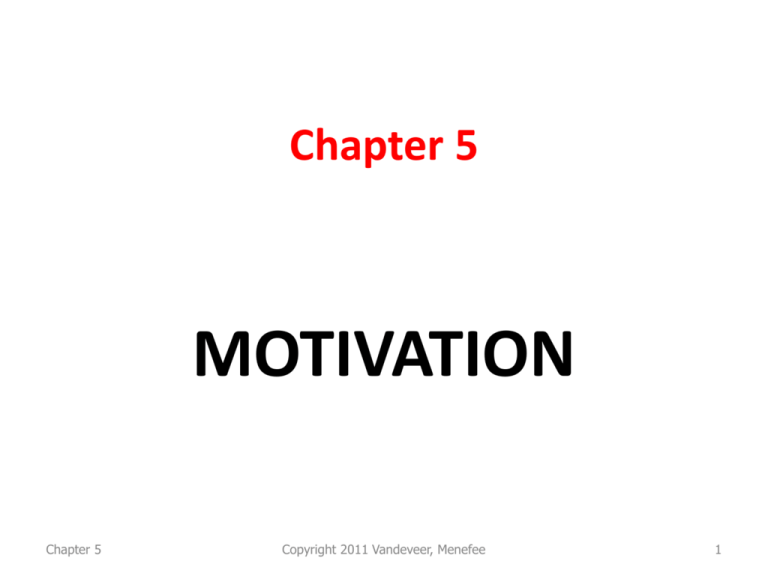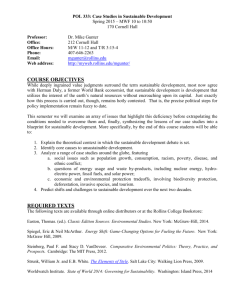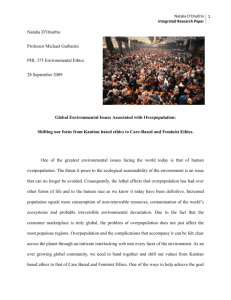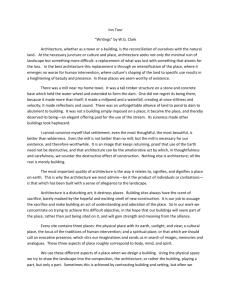Motivation
advertisement

Chapter 5 MOTIVATION Chapter 5 Copyright 2011 Vandeveer, Menefee 1 Motivation • Motivation is the willingness of a person to exert high levels of effort to satisfy some individual need or want. – The effort is a measure of intensity. – Need – Some internal state that makes certain outcomes appear attractive. Chapter 5 Copyright 2011 Vandeveer, Menefee 2 Maslow’s Hierarchy of Needs Self-actualization Ego or Esteem Needs Social/Belonging Needs Safety/Security Needs Physical Needs Chapter 5 Copyright 2011 Vandeveer, Menefee 3 Alderfer’s ERG Theory of Motivation All needs are operative at one time Existence Relatedness Chapter 5 Growth Copyright 2011 Vandeveer, Menefee 4 Herzberg’s Motivation-Hygiene Theory • Two independent scales: – Satisfaction and No Satisfaction • These are the motivators – Dissatisfaction and No Dissatisfaction • Hygiene or maintenance factors Chapter 5 Copyright 2011 Vandeveer, Menefee 5 Comparison of Hygiene and Motivators • Hygiene Factors – – – – – – – • Motivators Company policies Supervision Work conditions Salary Relationship with peers Status Security These factors contribute to job dissatisfaction. Chapter 5 – – – – – Recognition Achievement Work itself Responsibility Opportunity for advancement – Growth These factors contribute to job satisfaction. Copyright 2011 Vandeveer, Menefee 6 Satisfiers and Dissatisfiers Chapter 5 Copyright 2011 Vandeveer, Menefee 7 • What Supervisors thought employees wanted: – – – – – – – – – – Chapter 5 High wages Job security Promotion in the company Good working conditions Interesting work Personal loyalty of supervisor Tactful discipline Full appreciation of work done Help on personal problems Feeling of being in on things Copyright 2011 Vandeveer, 8 Menefee What employees say they wanted! • • • • • • • • • • Chapter 5 Full appreciation of work done Feeling of being in on things Help on personal problems Job security High wages Interesting work Promotion in the company Personal loyalty of supervisor Good working conditions Tactful discipline Copyright 2011 Vandeveer, 9 Menefee Comparison Supervisors 1. High wages 2. Job security 3. Promotion in the company 4. Good working conditions 5. Interesting work 7. Personal loyalty of supervisor 8. Tactful discipline 9. Full appreciation of work done 10. Feeling of being in on things Chapter 5 Employees 1.Full appreciation of work done 2. Feeling of being in on things 3. Help on personal problems 4. Job security 5. High wages 6. Interesting work 7. Promotion in the company 8. Personal loyalty of supervisor 9. Good working conditions 10. Tactful discipline Copyright 2011 Vandeveer, 10 Menefee McGregor’s Theory X and Theory Y • Theory X • Theory Y – Managers are pessimistic about workers’ capabilities. – Managers believe people dislike work, seek to avoid responsibility, and are not ambitious. – Employees must be closely supervised. Chapter 5 – Managers are more optimistic about workers’ capabilities. – Managers believe people enjoy work, willingly accept responsibility, exercise selfcontrol, have the capacity to innovate, and work is as natural as play. Copyright 2011 Vandeveer, Menefee 11 Chapter 5 Copyright 2011 Vandeveer, Menefee 12 McClelland’s Needs Theory • The need for Achievement: – is the drive to accomplish challenging goals. • The need for Power: – is the desire to control others; to influence others’ behavior according to one’s wishes. • The need for Affiliation: – is the desire for close relationships with others. Chapter 5 Copyright 2011 Vandeveer, Menefee 13 Goal Setting Theory • A goal is what a person tries to attain, accomplish, or achieve. – Goals tell an employee what needs to be done and how much effort will need to be expended. – A specific hard goal that is understood and accepted by the individual acts as an internal stimulus. – Specific hard goals produce a higher level of output than does the generalized goal of “do your best.” – The specificity of the goal itself acts as an internal stimulus. – Feedback is critical and acts to guide behavior. Chapter 5 Copyright 2011 Vandeveer, Menefee 14 Equity Theory of Motivation • Individuals compare their job inputs and outcomes with those of others and then respond so as to eliminate any inequities. • Equity theory recognizes that individuals are concerned not only with the absolute amount of reward for their efforts, but also with the relationship of this amount to what others receive. Chapter 5 Copyright 2011 Vandeveer, Menefee 15 Equity Theory of Motivation Performance Education Organizational Level Tenure/Seniority Gender INPUTS Chapter 5 Social Reward Benefits Recognition Actual Pay Perks OUTPUTS Copyright 2011 Vandeveer, Menefee 16 Equity Theory of Motivation • If an imbalance is perceived, what could be done? – Change the inputs. – Change the outcomes (Outputs). – Look at another measurement. – Change one’s self-perception. – Choose a different reference point. – Choose to leave. Chapter 5 Copyright 2011 Vandeveer, Menefee 17 Reinforcement Theory • A counterpoint to the goal-setting theory: – In the reinforcement theory, a behaviorist approach argues that reinforcement conditions behavior. – Reinforcement theorists see behavior as being behaviorally caused. – Reinforcement theory ignores the inner state of the individual and concentrates solely on what happens to a person when he or she takes some action. Chapter 5 Copyright 2011 Vandeveer, Menefee 18 Positive Reinforcement • Positive reinforcement means providing a positive response when a person demonstrates the desired behavior. • “People tend do that for which they get rewarded for doing.” Pat Carrigan, GM Bay City, MI Chapter 5 Copyright 2011 Vandeveer, Menefee 19 Negative Reinforcement • Negative reinforcement means rewarding by taking away uncomfortable consequences. Chapter 5 Copyright 2011 Vandeveer, Menefee 20 Punishment and Extinction • Punishment is the application of an undesirable consequence for an undesired behavior. • Extinction is the reduction in frequency of undesired behavior by removing the reward for such behavior Chapter 5 Copyright 2011 Vandeveer, Menefee 21 Expectancy Theory • The strength of a tendency to act in a certain way depends on the strength of an expectation that the act will be followed by a given outcome and on the attractiveness of that outcome to the individual. The theory focuses on three relationships: – effort-performance relationship. – performance-reward relationship. – reward-personal goals relationship. Chapter 5 Copyright 2011 Vandeveer, Menefee 22 Expectancy Theory • Effort-performance relationship: – the probability perceived by the individual that exerting a given amount of effort will lead to performance. • Performance-reward relationship: – the degree to which the individual believes that performing at a particular level will lead to the attainment of a desired outcome. • Reward-personal goals relationship: – the degree to which organizational rewards satisfy an individual’s personal goals or needs and the attractiveness of those potential rewards for the individual. Chapter 5 Copyright 2011 Vandeveer, Menefee 23 Why study this? Cost of Non-Motivated Employees – High turnovers – Higher training costs – Higher absenteeism – Increased errors – Minimum performance – Violation of safety rules – Poor attitudes reflect on entire organization, not just the individual – Customer relation/service issues Chapter 5 Copyright 2011 Vandeveer, Menefee 24 Summary • • • • • • What motivation is – definition Maslow’s Hierarchy of Needs Theory Alderfer’s ERG Theory Model Herzberg’s Motivation-Hygiene Theory McGregor’s Theory X and Theory Y concept McClelland’s Needs Theory Chapter 5 Copyright 2011 Vandeveer, Menefee 25 Summary • • • • Goal-Setting Theory Equity Theory of Motivation Reinforcement Theory Expectancy Theory Chapter 5 Copyright 2011 Vandeveer, Menefee 26








